Profliand
On this page, you find all documents, package deals, and flashcards offered by seller profliand.
- 69
- 0
- 5
Community
- Followers
- Following
1 Reviews received
74 items
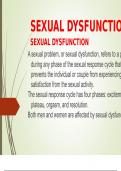
Sexual Dysfunction
SEXUAL DYSFUNCTION A sexual problem, or sexual dysfunction, refers to a problem during any phase of the sexual response cycle that prevents the individual or couple from experiencing satisfaction from the sexual activity. The sexual response cycle has four phases: excitement, plateau, orgasm, and resolution. Both men and women are affected by sexual dysfunction. Sexual problems occur in adults of all ages. However, older adults are more affected due to changes associated with n...
- Class notes
- • 27 pages •
SEXUAL DYSFUNCTION A sexual problem, or sexual dysfunction, refers to a problem during any phase of the sexual response cycle that prevents the individual or couple from experiencing satisfaction from the sexual activity. The sexual response cycle has four phases: excitement, plateau, orgasm, and resolution. Both men and women are affected by sexual dysfunction. Sexual problems occur in adults of all ages. However, older adults are more affected due to changes associated with n...
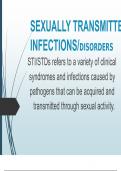
Sexually Transmitted Infections
SEXUALLY TRANSMITTED INFECTIONS/DISORDERS STI/STDs refers to a variety of clinical syndromes and infections caused by pathogens that can be acquired and transmitted through sexual activity. STI/STDs are infections acquired during heterosexual or homosexual intercourse with an infected person. SEXUALLY TRANSMITTED INFECTIONS/ DISORDERS Characteristics shared by sexually transmitted diseases/infections STDs can be transmitted by any sexual activity between opposite sex or same sex ...
- Class notes
- • 89 pages •
SEXUALLY TRANSMITTED INFECTIONS/DISORDERS STI/STDs refers to a variety of clinical syndromes and infections caused by pathogens that can be acquired and transmitted through sexual activity. STI/STDs are infections acquired during heterosexual or homosexual intercourse with an infected person. SEXUALLY TRANSMITTED INFECTIONS/ DISORDERS Characteristics shared by sexually transmitted diseases/infections STDs can be transmitted by any sexual activity between opposite sex or same sex ...
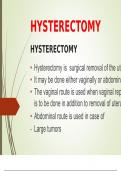
Hysterectomy
HYSTERECTOMY • Hysterectomy is surgical removal of the uterus • It may be done either vaginally or abdominally • The vaginal route is used when vaginal repair is to be done in addition to removal of uterus • Abdominal route is used in case of - Large tumors - Exploration of pelvic cavity - Need to remove fallopian tubes and ovaries HYSTERECTOMY: Indications Dysfunctional uterine bleeding Endometriosis Fibroids Uterine rupture Chronic PID Malignancies in early stage...
- Class notes
- • 20 pages •
HYSTERECTOMY • Hysterectomy is surgical removal of the uterus • It may be done either vaginally or abdominally • The vaginal route is used when vaginal repair is to be done in addition to removal of uterus • Abdominal route is used in case of - Large tumors - Exploration of pelvic cavity - Need to remove fallopian tubes and ovaries HYSTERECTOMY: Indications Dysfunctional uterine bleeding Endometriosis Fibroids Uterine rupture Chronic PID Malignancies in early stage...
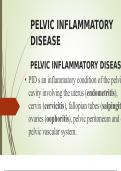
Pelvic Inflammatory Disease
PELVIC INFLAMMATORY DISEASE PELVIC INFLAMMATORY DISEASE • PID s an inflammatory condition of the pelvic cavity involving the uterus (endometritis), cervix (cervicitis), fallopian tubes (salpingitis), ovaries (oophoritis), pelvic peritoneum and or pelvic vascular system. • May be acute, sub-acute, chronic or recurrent • It may be confined to one structure (localized) or involve all the structures (widespread) PELVIC INFLAMMATORY DISEASE Causative organisms • The main causative org...
- Class notes
- • 19 pages •
PELVIC INFLAMMATORY DISEASE PELVIC INFLAMMATORY DISEASE • PID s an inflammatory condition of the pelvic cavity involving the uterus (endometritis), cervix (cervicitis), fallopian tubes (salpingitis), ovaries (oophoritis), pelvic peritoneum and or pelvic vascular system. • May be acute, sub-acute, chronic or recurrent • It may be confined to one structure (localized) or involve all the structures (widespread) PELVIC INFLAMMATORY DISEASE Causative organisms • The main causative org...
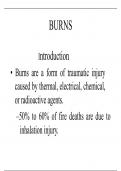
Pathology Notes
it has pathology notes on burns, the biology of cancers and tumor, altered cellular tissue biology, pathological calcification, and wound healing
- Package deal
- • 5 items •
- Wound Healing • Class notes
- pathological calcification • Class notes
- Altered cellular tissue biology • Class notes
- Biology of cancers and tumors • Class notes
- Pathology - Burns • Class notes
it has pathology notes on burns, the biology of cancers and tumor, altered cellular tissue biology, pathological calcification, and wound healing

Pathology - Burns
BURNS Introduction • Burns are a form of traumatic injury caused by thermal, electrical, chemical, or radioactive agents. –50% to 60% of fire deaths are due to inhalation injury. Pathophysiology • Burn Injury • Physiologic reaction to a burn is similar to the inflammatory process. –Adjacent intact vessels dilate, causing redness and blanching with pressure. –Platelets and leukocytes begin to adhere to the vascular endothelium as an early event in the inflammatory process. Pa...
- Package deal
- Class notes
- • 46 pages •
BURNS Introduction • Burns are a form of traumatic injury caused by thermal, electrical, chemical, or radioactive agents. –50% to 60% of fire deaths are due to inhalation injury. Pathophysiology • Burn Injury • Physiologic reaction to a burn is similar to the inflammatory process. –Adjacent intact vessels dilate, causing redness and blanching with pressure. –Platelets and leukocytes begin to adhere to the vascular endothelium as an early event in the inflammatory process. Pa...
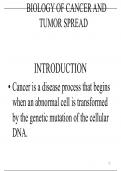
Biology of cancers and tumors
BIOLOGY OF CANCER AND TUMOR SPREAD INTRODUCTION • Cancer is a disease process that begins when an abnormal cell is transformed by the genetic mutation of the cellular DNA. • This abnormal cell forms a clone and begins to proliferate abnormally, ignoring growth-regulating signals in the environment surrounding the cell. INTRODUCTION • The cells acquire invasive characteristics, and changes occur in surrounding tissues. • The cells infiltrate these tissues and gain access to lymph ...
- Package deal
- Class notes
- • 43 pages •
BIOLOGY OF CANCER AND TUMOR SPREAD INTRODUCTION • Cancer is a disease process that begins when an abnormal cell is transformed by the genetic mutation of the cellular DNA. • This abnormal cell forms a clone and begins to proliferate abnormally, ignoring growth-regulating signals in the environment surrounding the cell. INTRODUCTION • The cells acquire invasive characteristics, and changes occur in surrounding tissues. • The cells infiltrate these tissues and gain access to lymph ...
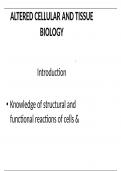
Altered cellular tissue biology
Introduction • Knowledge of structural and functional reactions of cells & tissues to injurious agents - key in understanding of disease processes • Altered cellular & tissue biology can result from adaptation, injury, neoplasia, aging or death CELLULAR ADAPTATION • An alteration that enables the cell to maintain a steady state despite adverse conditions • Adapted cell is neither normal nor injured –Condition – in between the two states • Forms – atrophy, hypertroph...
- Package deal
- Class notes
- • 86 pages •
Introduction • Knowledge of structural and functional reactions of cells & tissues to injurious agents - key in understanding of disease processes • Altered cellular & tissue biology can result from adaptation, injury, neoplasia, aging or death CELLULAR ADAPTATION • An alteration that enables the cell to maintain a steady state despite adverse conditions • Adapted cell is neither normal nor injured –Condition – in between the two states • Forms – atrophy, hypertroph...
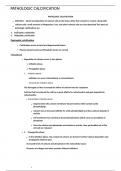
pathological calcification
PATHOLOGIC CALCIFICATION Definition – Abnormal deposition of calcium salts in the tissue other than osteoid or enamel. Along with calcium salts, small amounts of Magnesium, iron, and other mineral salts are also deposited Two types of pathologic calcifications are- 1. Dystrophic calcification 2. Metastatic calcification Dystrophic calcification Calcification occurs in dead and degenerated tissues Plasma calcium levels and Phosphate levels are normal Pathogenesis Deposition of calcium...
- Package deal
- Class notes
- • 3 pages •
PATHOLOGIC CALCIFICATION Definition – Abnormal deposition of calcium salts in the tissue other than osteoid or enamel. Along with calcium salts, small amounts of Magnesium, iron, and other mineral salts are also deposited Two types of pathologic calcifications are- 1. Dystrophic calcification 2. Metastatic calcification Dystrophic calcification Calcification occurs in dead and degenerated tissues Plasma calcium levels and Phosphate levels are normal Pathogenesis Deposition of calcium...
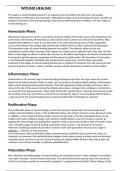
Wound Healing
The stages of wound healing proceed in an organized way and follow four processes: hemostasis, inflammation, proliferation and maturation. Although the stages of wound healing are linear, wounds can progress backward or forward depending on internal and external patient conditions. The four stages of wound healing are: Hemostasis Phase Hemostasis is the process of the wound being closed by clotting. Hemostasis starts when blood leaks out of the body. The first step of hemostasis is when blood ...
- Package deal
- Class notes
- • 2 pages •
The stages of wound healing proceed in an organized way and follow four processes: hemostasis, inflammation, proliferation and maturation. Although the stages of wound healing are linear, wounds can progress backward or forward depending on internal and external patient conditions. The four stages of wound healing are: Hemostasis Phase Hemostasis is the process of the wound being closed by clotting. Hemostasis starts when blood leaks out of the body. The first step of hemostasis is when blood ...

Driver's Ed: Chapter 7 Test Study Questions and Answers